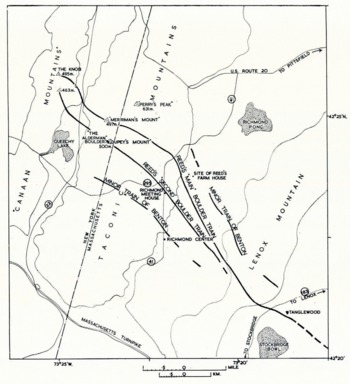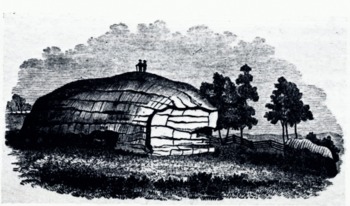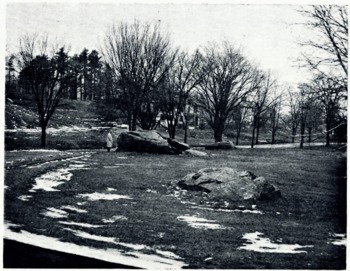Stephen Reed earned an honoured place in the history of western Massachusetts because of his contributions as a physician, schoolmaster, editor, scientific agriculturist, columnist, lecturer and sponsor of worthy causes and good works. Today he is but dimly remembered in the annals of American geology for his contribution to glacial theory and for his pioneering descriptions, published and unpublished, of the Richmond boulder train. This is a remarkable sequence of large amphibolite boulders that extend from a unique source point, The Knob or “Frye’s Hill” in New York State, for several tens of kilometers south-eastward into Massachusetts (Fig. 1). Reed first reported on this “chain of erratic serpentine rocks” in a local journal, the Lenox Farmer, in 1842. This article was not available to the writer, although several early accounts refer to this paper. Later, Reference ReedReed (1845) read a scientific account of the boulder train at a national geological meeting. This paper sparked a trans-Atlantic debate that involved many leading geologists, including Sir Charles Lyell, Edward Hitchcock, Ebenezer Emmons, James Hall and Louis Agassiz. This debate was not resolved until the concept of glaciation was widely accepted in the sixth and seventh decades of the last century.

Fig. 1. Sketch map showing the location of the principal boulder trains in the Richmond, Massachusetts, area
Boulder trains and other less well-defined sequences of erratic blocks had been described earlier, having been observed in the late eighteenth century by, among others, de Reference SaussureSaussure (1803, Vol. 1, p. 206) in the vicinity of Lake Geneva, and by Reference DurocherDurocher (1842, p. 94) in Poland and Russia at about the same time as Reed’s first paper. Yet the Richmond boulder train probably created more interest, because it was studied in the field by a relatively large number of eminent and articulate geologists, because its discovery and published descriptions happened to fall within the fermentative period when the broader question of the origin of the drift sheets was being vigorously debated on both sides of the Atlantic, and because of its conspicuous nature. This last aspect is notable, for unlike many other chains of erratics or indicator fans (Reference FlintFlint, [1957], p. 123), which are traceable only by careful study of buried fragments in till, this feature is clearly a train of surface boulders. For example, it maintains its narrow width for at least 29 km., and it is composed of fragments typically 5 m. in diameter, a few being 15 to 29 m. across (Fig. 2). Today, in spite of powerful earth-moving equipment and dynamite, many boulders are conspicuous in the open fields (Fig. 3).

Fig. 2. One of the larger amphibolite boulders (from Lyell’s (1871) account)

Fig. 3. Typical distribution of amphibolite boulders in an open field. These are from the “second train” of Reed. December, 1965
Stephen Reed was born in Cornwall, Connecticut, in 1801 and attended Yale University, graduating in 1824. There he received, for his time, a sound scientific education, coming in contact with Professor Benjamin Silliman, and taking courses in chemistry, mineralogy, geology and natural philosophy (personal communication from Yale University Graduate School, 1966).
He subsequently “passed through” medical school at Yale, practiced for a short while in Goshen and in Roxbury, Connecticut, and then moved to Richmond, Massachusetts, in 1831. His interests apparently ranged far beyond medicine, for in 1838 he abandoned his practice, after which, in Reed’s words, he “left the people to go their own way to death” (personal communication from Yale University Graduate School, 1966). He then founded a boarding school for boys, which was regarded as both “prosperous and useful” (Berkshire County Eagle, 1877). It was during his years as a schoolmaster in Richmond that he apparently took notice of the lines of erratic boulders that crossed his farm fields and those to the north-west and south-east (Fig. 1).
His observations were unhampered by the dense forest that now covers much of the Berkshire Hills and Taconic Mountains, for upland pastures were then more extensive, not only because of more intensive grazing, but because of the demand for hardwood for the local charcoal-burning iron furnaces. More important, Reed’s geologic training sharpened his powers of observation, for although the amphibolite boulders are different on close inspection from the local schist, limestone and quartzite, the weathered appearance of the erratics would not set them distinctly apart to the casual observer. As a farmer, Reed was also aware of their unique size, because the larger boulders in the train could not be easily broken or transported to the edges of the farm fields.
Dr. Reed also had the advantage of living during a golden age of intellectual development in Berkshire County. Literary figures of national reputation were his neighbors, writers whose subject matter frequently dealt with nature and natural phenomena (Reference Tague and KimballTague and Kimball, 1961, p. 27–29). Herman Melville, Nathaniel Hawthorne, William Cullen Bryant, Henry Wadsworth Longfellow and Oliver Wendell Holmes lived nearby. As Reed was active in community and county affairs, he probably could not escape the influence of the intellectual climate these writers helped to create. Nature study and scientific outings were popular pastimes. A typical excursion occurred in 1869, when a young men’s association from Pittsfield, in the company of Dr. Reed, celebrated the hundredth anniversary of the birth of Baron von Humboldt on Perry’s Peak (Fig. 1), complete with refreshments and the reading of odes, and ending with a cross-country hike along the boulder train (Reference AnninAnnin, 1964, P. 133).
Reed’s first presentation of his observations to a geologic audience (Reference ReedReed, 1845) noted the essential aspects of the boulder train: the great size of the boulders; their lithology, especially their hardness and toughness; their distribution along a length of 29 km.; the fact that the width of the train did not exceed about 100 m.; the concentration of the larger blocks on the south-eastern (or down-glacier) slopes; and significantly, the transport across hills higher than the source of the boulders. Except for careful plotting on accurate base maps and supplementary petrographic and particle-size studies, Reed’s account needs little improvement. In later years when lecturing on the boulder train, he explained its origin in a manner any Berkshire County farmer could understand: “If you should find apples of a particular kind strewn along the road, and following them up should find a cart loaded with fruit of the same kind, you would have no doubt where they came from” (Pittsfield Evening Sun, 1877, p. 2).
Dr. Reed’s account in a local journal in 1842 caught the eye of Edward Hitchcock, the State Geologist of Massachusetts, who published an abstract (Reference HitchcockHitchcock, 1844) and later a longer account (Reference HitchcockHitchcock, 1845). He made a few refinements in Reed’s observations, notably that the boulders extended from their source more than 29 km. to the south-east, that there was a second train south-west of the original chain, and that the blocks were on the surface and not in the drift. In attempting to explain their origin he discounted iceberg transport, because of the large number of boulders and the straightness of the train. He rejected “packed ice” (probably meaning sea ice) as a vehicle, because it would have to be much thicker than modern sea ice and because transport to the south-east would be blocked by the topography. He could not imagine that water currents could have transported such large fragments, and he rejected the idea that the boulders were a medial moraine in a glacier, as he believed that the glacier could not have flowed up-hill over the ridges. He also did not believe they could be “streams of stones”, such as Darwin had described from the Falkland Islands, as the boulders were not confined to the valleys. As an honest scientist, Hitchcock stated that he knew no explanation and that more information was needed. His failure to reach a conclusion may be puzzling, as he is on record (Reference HitchcockHitchcock, 1841[a], p. 3a–11a; Reference Hitchcock1841 [b]) as stating the first widely circulated explanation in America of the glacial origin of the drift.
The persons who perhaps gave the most imaginative explanation were Reference Rogers and RogersRogers and Rogers (1845, Reference Rogers and Rogers1846). They observed that the two main trains came from depressions at the crest of the hill from which they originated, and that the trains were slightly sinuous. Rejecting glacial transport and iceberg drifting, they held that the train was the result of a sudden discharge of the Arctic Ocean southward, as a wave of translation (not unlike a tsunami). The Arctic waters picked up speed sweeping down the south-west slopes of the Adirondack Mountains and drove enormous ice islands against the summit of The Knob. This produced a vortex “endowed with an excess gyratory or spiral velocity” which had a pendant column (similar to a tornado funnel or dust devil in the atmosphere). The whirlpool then gathered into its rotating column blocks from the summit and strewed them in a line along which its pendant apex dragged along the ground (Reference Rogers and RogersRogers and Rogers, 1845, p. 79).
Only a few years later came the first published suggestion that the Richmond boulder train was of glacial origin. Reference DesorDesor (1848) stated that similar trains of boulders parallel the courses of glaciers in Switzerland. However, as frequently occurs in the history of science, the true origin was not generally accepted until several decades had passed.
Sir Charles Lyell was among those who did not accept a glacial origin for the Richmond train (Reference LyellLyell, 1855, Reference Lyell1871). In the company of Reed (whose name he spelled Reid), Hitchcock and James Hall, Lyell carefully traversed the Richmond area and plotted a total of seven parallel lines of boulders. However, the additional five trains, four of which were plotted south-west and one north-east of the main trains, were said to be composed mostly of limestone blocks. As the limestone trains were not traced to a lithologically unique point source, limestone being one of the commonest local rocks, they probably should not be regarded as boulder trains. Perhaps Lyell’s chief contribution was his careful description, which was widely circulated in a journal (1855) and in his tome, The geological evidences of the antiquity of Man (1871). He described the largest boulder in the train, the “Alderman” on “Dupey’s Mount” (Fig. 1), which is 29 m. long, and noted that in some localities as many as 40 or 50 blocks could be observed lying near each other “the smallest of them larger than a camel”. He also published a somewhat spectacular sketch of a block, 16 m. long, near the Richmond Meeting House (Fig. 2). This information certainly stimulated wide discussion and speculation. However, his explanation was that the blocks were transported from The Knob by “coast ice” which was able to drift south-westward through the saddles of the ridges (Reference LyellLyell, 1871, p. 361). He rejected glacial transport, for he believed that the flow of glacial ice would have caused the boulders to fan out rather than be deposited in a line (Reference LyellLyell, 1871, p. 350). Indeed, many, if not most, of these features elsewhere are in fan patterns, as implied in Flint’s term, indicator fan (Reference FlintFlint, [1957], p. 123).
The Reverend John B. Perry, like Reed an amateur geologist, next made a contribution to the discussion of the boulder train (Reference PerryPerry, 1871), publishing a year before the appearance of Reference AgassizAgassiz’s (1872) short but definitive opinion on its origin. Perry postulated that the train was deposited by a glacier that had thinned to about 200 m. and moved around the summit of The Knob (Reference PerryPerry, 1871, p. 168). Reference AgassizAgassiz (1872, p. 385) discounted an iceberg mechanism for transport of the boulders, because he observed the blocks were rounded and scratched. He suggested that the boulder train was caused by an immense, not local, ice sheet, not less than about 3,300 to 4,000 m. thick. Agassiz also stated that Reed had not received due credit for his observations.
Stephen Reed in Reference Reed1873, now an elderly and distinguished citizen of Berkshire County, published another scientific paper on the boulder trains. In the years since the publication of his first papers, he had become the editor and publisher of a weekly journal, had purchased an agricultural supply house, had become active in community affairs in Pittsfield, and had lectured and written newspaper articles on geology and natural history. In his last paper, published only a year after Agassiz effectively ended the boulder-train debate, Reed described a boulder train 2 miles (3.2 km.) south of the “main” train (Fig. 1). He noted that glacial transport was supported by the fact that grinding and grooving were greater on the up-glacier slopes, that the larger blocks were found on the down-glacier slopes, and that some boulders were found at higher elevations than their sources (Reference ReedReed, 1873).
The most complete study of the boulder train was made by Reference BentonBenton (1878) in a paper published a year after the death of Dr. Reed. Benton mapped the boulders, using his own remarkably good base map, and made measurements of boulder densities and sizes. Although Benton was able to trace the main and (less continuous) secondary trains and fragments of two others, he could not find evidence for the other three trains of Lyell (Fig. 1). He substantiated Reed’s observations, showing that boulders on the north-west slope of the “Canaan Mountains” averaged about 4 m. in diameter, whereas those on the south-east slope averaged about 5 m. Boulders in the Lenox-Stockbridge valley (near Tanglewood) averaged only 60 cm. in diameter (Fig. 1).
By the 1870’s, the glacial hypothesis for the origin of drift was widely, although not universally, accepted (Reference FlintFlint, [1957], p. 5). Yet the Richmond boulder train continued to stimulate interest and discussion, locally and nationally. A description of the boulder train and a sketch of the life of Dr. Reed appeared prominently in a comprehensive history of Berkshire County (Reference SmithSmith, 1885, Vol. 1, p. 3; Vol. 2, p. 237, 418, 490–91) and recently in a history of the town of Richmond (Reference AnninAnnin, 1964, p. 132–33), and the feature is mentioned in most of the standard textbooks on glacial geology (Reference WrightWright, 1889, p. 210; Reference FlintFlint, [1957], p. 126; Reference CharlesworthCharlesworth, 1957, p. 365). The erratic blocks were re-studied early in this century by Reference TaylorTaylor (1910), who essentially supported the observations of Reed and Benton, and who presented evidence for a second diverging train of buried amphibolite boulders trending southward from The Knob. Taylor implied that the south-trending train was evidence for an advance of the ice sheet in western Massachusetts prior to the one that deposited the Richmond train. More recently, Reference ChuteChute (unpublished), in the course of investigations of the iron deposits of Berkshire County, reviewed the literature on the Richmond train and discussed some of its striking characteristics.
Among all the participants in the boulder-train debate, Stephen Reed, amateur geologist, probably deserves the most credit for presenting, directly and indirectly, solid evidence supporting the theory of continental glaciation.





